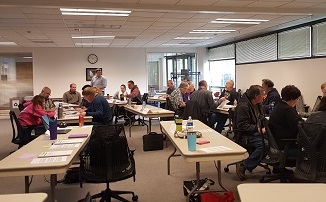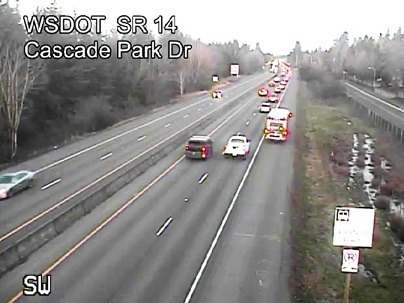An approach known as Practical Solutions is allowing the Washington State Department of Transportation (WSDOT) to improve and maintain the state’s transportation system in a more sustainable and cost-effective manner, while getting the most value out of its transportation investments.
Practical Solutions entails focusing first and foremost on the need for the project, rather than focusing only on existing standards and how to meet them. The approach is focused on the maximum benefit to the transportation system, rather than benefits of an individual project, allowing more needs to be addressed system-wide.
Practical Solutions emphasizes managing assets to their appropriate condition and service levels and integrating transportation modes to complement each other; it advocates the right investments in the right places at the right times with the right approach. Agency staff members are being empowered to think both pragmatically and creatively to come up with smart solutions, using the growing body of data and technology tools available to them.

“Working together to align our resources and make smart, innovative, and integrated decisions to solve transportation system needs is critical in today’s resource-constrained environment,” said Steve Roark, Director of the Development Division at WSDOT.
WSDOT’s Practical Solutions approach focuses on the following principles:
- Starting with a clear purpose and need;
- Considering resource constraints and life cycle costs, including operations and maintenance;
- Engaging stakeholders and looking for partnerships;
- Considering overall system performance;
- Considering incremental, phased solutions; and
- Applying innovation and creativity.
An Evolving Approach
Practical Solutions began in 2013 as part of a broader reform process instituted by the state’s transportation secretary. Since that time, the approach has continued to be of vital importance across the agency, and it is included as one of WSDOT’s three strategic goals, along with inclusion (which incorporates diversity and engagement) and workforce development.
Implementation of the approach has evolved from a two-part strategy that emphasized coordinated planning and design, to broader application. Practical Solutions now applies to everything the agency does, from administration and management to maintenance, and everything in-between. For project development, the focus on project purpose and need is sustained throughout all phases: planning, program management, environmental analysis, design, construction, and operations. The ultimate goal is to enable more flexible and sustainable transportation investment decisions, integrated across all modes and coordinated with agency partners and their systems.
While cost-effectiveness and state of good repair are cornerstones of the approach, so is community engagement and interdisciplinary, collaborative decision-making. Local stakeholders are being engaged at the earliest stages of defining project scope. Project design is based on the larger context – both land use and transportation requirements. However, the approach does not mean compromising safety, environmental compliance, or standards.
Cost Savings, Timeliness Benefits
By focusing on a broader range of solutions that go beyond traditional practices, planners and engineers are encouraged to be more creative. In addition, early engagement with the public helps make customer needs an early foundation of the process. The emphasis on planning helps to avoid overbuilding and it opens up possibilities for more, smaller projects that allow for recent advances in technology to be harnessed as they unfold (such as transportation systems management and operations and transportation demand management).
For example, at certain intersections with high crash rates, WSDOT installed warning signs that flash when cars are present, reducing crash rates by 32%-50% at a cost of less than $50,000 each. This avoided costly installation of more traditional traffic signals or roundabouts that would have cost upwards of $1 million each.
In another example, WSDOT reinforced the shoulders of SR 14 between I-205 and SE 164th Avenue to provide access for buses during heavy traffic. This solution took much less time to implement than a traditional, expensive road widening project, while improving bus transit time by 17%.

WSDOT tracks and reports on actual practical design savings for its Connecting Washington program, and those savings are reprogrammed to future projects by the state legislature.
Challenges
According to Roark, “WSDOT is working to maximize the outcomes of good, integrated planning. We’re also working to alter our design processes so that they harvest those planning outcomes (instead of redoing them after a project need is established). These are real challenges!”
“Practical solutions require full understanding of the environmental and land use context and the purpose and need for action. These, together with the overall system needs, inform the basis of our design solutions.”
In addition, he said, “it’s sometime difficult for agency staff and our partners to understand that the most reasonable and cost-effective way to address problems and needs is not to develop and implement what would be considered ‘ultimate solutions.’”
In many cases, developing integrated, multimodal solutions that are delivered in incremental or phased solutions have a much better return-on-investment than delivering the full suite of long-range solutions.
“Transportation agencies do not have the resources to address all needs, so it is crucial that they have a process to stretch their available resources as far as possible to meet today’s and tomorrow’s needs,” he added.
Training
WSDOT has a wide range of training underway to help staff implement the approach. The available curriculum includes a Practical Solutions 101 session that covers basic principles, which most employees have taken, and a more in-depth 201-level course that is underway. In addition, the agency is conducting Practical Solutions labs, bringing in subject matter experts to help design teams on specific projects.
WSDOT also provides a range of resources on its Practical Solutions web page, including an and an online eLearning program.
Similar approaches – including the Federal Highway Administration’s Performance-Based Practical Design – have been successfully adopted by numerous states. FHWA has provided support, including case studies, workshops, and other training efforts
Lessons Learned
For its part, WSDOT has learned some lessons along the way that may be useful to other state DOTs, Roark said.
First, the cookie cutter approach to project design is obsolete. Second, collaboration improves the quality of a project’s effect on the multimodal transportation system; learning together and sharing information builds trust. Third, gaining political support for practical solutions to transportation infrastructure is essential. Fourth, small fixes can make a big difference.
And finally, Roark said, “just keep talking and asking questions throughout the process. Highlighting good approaches pays dividend and will help achieve a common understanding of Practical Solutions and how to apply it in everything we do.”
For more information, link to WSDOT’s Practical Solutions web page, or contact Steve Roark at [email protected].